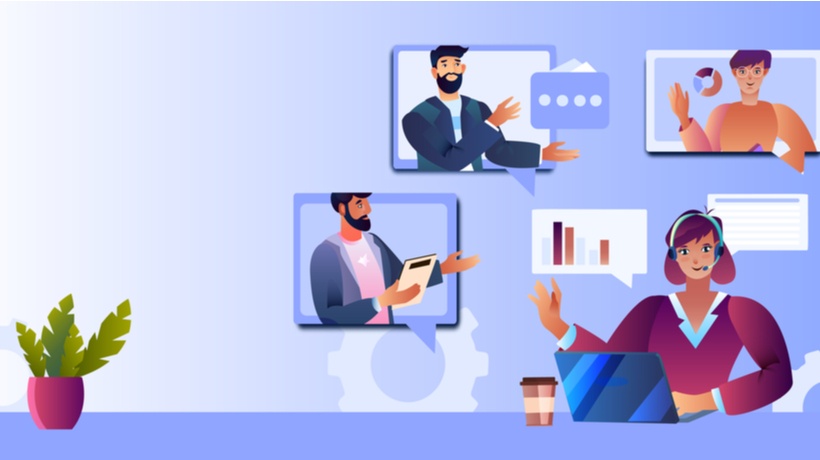How Train A Virtual Workforce: Tips To Overcome 6 Common Obstacles
The future of work is a hybrid model, or blend, of virtual remote work and more traditional in-person activities conducted onsite. As business processes transform to meet the changing landscape of work, organizations will look to Virtual Instructor-Led Training (VILT) and eLearning development as a solution. Training best practices will include use of microlearning to embed learning in the flow of work, and L&D teams will be challenged to provide the tools and resources to improve both the digital work and online class experience.
Finding the right training plan to create real, positive, measurable business transformation and performance results could be a challenge. But there are strategies for custom eLearning development to optimize the experience, and best practices for learning and development teams to support leadership and HR departments as they build a culture of learning that supports employees – and builds their teams.

6 Challenges And Cost-Effective Solutions For The Future Of Work
Let’s take a look at some of the challenges and solutions for the future of work.
Challenge #1: How to optimize flexibility for a remote workforce?
Get smart about the best uses of technology in your workplace.
As technology evolves, so too will learning technology tools that may be used to engage with your workforce and increase successful outcomes on-the-job. As the workplace moved online, we saw many organizations scrambling and using virtual classrooms, VILT, and video conferencing as a substitute for many functions. That stopgap method was fine for a while, but we now have the opportunity to redesign the employee experience with intentional use of new digital tools to accomplish the same goals in a more effective way. Those new tools include:
Learning Portals
Does your organization have a digital workplace ready for your employees to access? If not, it is time to get one. A learning portal can be as simple as a landing page with a list of resources and contacts. Learning portals with additional functions that align with your business processes will help increase the success of your efforts at improving your remote workplace.
Accessible, Interactive Digital Tools
Your employees are remote, which means they might not always have instant access to a team member or other personnel to provide quick answers to important process questions. For those cases, your organization should be prepared to provide learning in the flow of work, as well as resources that may be easily accessed to answer questions. For example, a basic digital toolkit might include easily searchable, downloadable interactive PDFs and videos with rich media to provide quick answers to questions and guidance on processes. This will increase productivity to have resources available in a library of learning content and/or for download to keep as a quick guide resource.
Mobile Learning And Apps
You want to try to deliver content to employees in the same ways they get information in their daily life. Consider: If you want to find a shop or restaurant near you, do you use a device already in your possession – such as a phone – or do you run home or back to the office to sit in front of your desktop? Information is available to us everywhere, and if you want your organization to connect with remote employees on their terms, then mobile-ready and accessible content and technology are a must.
The goal is to have relevant content ready for employees at the point of need. Organizations should invest in the resources and technology to support employee success.
Challenge #2: How will managers, leaders and other departments within your organization respond to the challenge of leading remote teams?
Training and development of your virtual workforce shouldn’t be limited to onboarding and upskilling existing employees. Strategic leadership training initiatives may be used to maximize a successful transition to the hybrid workplace.
Executive involvement is key to the strategic success of adopting any new process or initiative, and the increased use of technology is no exception. Building an organizational culture of learning and continuous improvement requires that senior leaders participate in ongoing training and development. The leadership training at your organization should be customized to your needs, and may include training on interpersonal skills, use of workplace tools or processes, and may even include a development process for new management.
Challenge #3: How will learning be used to support virtual classrooms and on-the-job needs?
Embed learning in the flow of work.
It takes more than adoption of technology to make learning a consistent, available process during a workday. There are best practices developed by instructional designers and learning and development teams to make learning a consistent, memorable part of daily work. For example, use of microlearning is an important strategy. In essence, you take a training programming that was traditionally longer and break it into more manageable, bite-sized lessons that are then used repeatedly.
Challenge #4: How do we create communities and build culture when our workplace teams are fragmented and distant outside of a central office?
To create a sense of community within a virtual workforce, organizations can make use of learning resources and other digital tools to enhance communication, increase connections and build branding efforts.
How? One method is to increase training opportunities. Many employees feel that an increase in opportunities to learn and grow within their roles is a benefit, and that employers that offer training demonstrate investment. Beyond that, eLearning may be used the build interactive, engaging platforms, and train staff in its use.
The final piece of the puzzle is to focus on the learner experience. This would be true whether the training program is in person or delivered in a virtual classroom. Think about how many people use popular sites such as Amazon, Facebook, Instagram and YouTube, and how the user experiences those sites. In general, people are served up content that might be of interest to them, and platforms are designed to be and interactive. The user interface must be friendly, intuitive, and easy to navigate. Regular use of the web, Google, and social media has set a standard for the level of expectations most people have about how to navigate online.
Currently, most legacy learning management systems do not deliver on employee expectations. Organizational content that isn’t well organized, easily searchable, visually appealing, intuitive and interactive decreases the effectiveness of the material. When employees can’t find what they need, or are dissatisfied with the experience overall, the level of engagement drops.
Challenge #5: Accessibility: How equitable, inclusive, and accessible are your digital tools and learning processes?
It builds community, cohesive teams, and a more successful organization overall when all members of your team are recognized, supported, and encouraged to participate fully.
Efforts to increase accessibility can be supported in a variety of ways. Platforms may be built to address basic concerns about usability for those with disabilities. In addition, trainings may be designed and implemented to encourage all members of your team to speak up, and to build a culture of respect, listening and teamwork. Just the addition of a dedicated training on these subjects can increase awareness, and create positive support and change for the initiatives in your organization.
Challenge #6: How to create an effective eLearning solution for the unique needs of your organization?
In order to create an eLearning solution that meets the needs of your organization, it’s important to start with gathering information to create a roadmap to an intentional redesign.
Perhaps the most important step to implement an effective eLearning solution is the first one. You’ll want to start by gathering information about the needs at your organization. Consider the following questions:
- What are the greatest areas of need? Does your team have knowledge or performance gaps?
- How are employees currently accessing information, and what are their needs?
- Which metrics would determine success for the project?
- What is your budget and timeline?
You can gather that information in a variety of ways. Some ideas include use of surveys to get information directly from employees; gathering metrics about current use of informational tools and processes; and consulting with leadership to align to the strategic direction.
Of course, you may also want to make use of performance consultants to help gather that valuable information and provide insights that will help you determine what changes need to be made. Performance consultants at the front end of a learning and development initiative will use their experience to make a critical needs analysis and give valuable recommendations to make the most of the design process as you build a plan for eLearning.
Conclusion
Technology is advancing at a staggering rate. Over the last year there has been much speculation about the future of work post pandemic. In fact, it is possible to see the future and plan for it now. How? It is true what they say: Change is the only constant. But what hasn’t changed is the AllenComm commitment to share knowledge with those that need it. We’re passionate about the principles behind the distribution and acquisition of knowledge, and those will remain the same regardless of the advances in technology coming our way.
Download the eBook The Future of Work: The Role of Instructional Design In Converting VILT To eLearning In 2021 to make the switch to virtual training and support your remote work teams!









